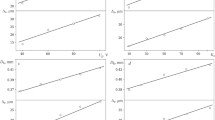The problem of determining the strength of cylindrical ceramic parts on punching holes in them is examined within the framework of the theory of developed evaporation of matter by laser radiation. Analytical relations are obtained for calculating the power density of laser radiation, leading to the destruction of the lateral surface of parts by the pressure of gaseous products as a function of the ratio of the hole radius to the part radius, the ratio of the part radius to the radius of the hole in the part, and the thickness of the lateral surface of the part as a function of the power density of the acting laser radiation. The applicability of the results obtained for determining the strength of cylindrical parts is shown for the example of P-25 technical ceramics based on magnesium oxide. When the ratio of the hole radius to the part radius is less than 0.3, the part can be considered as an infinite body. In this case the computational error will not exceed 10%.



Similar content being viewed by others
References
A. S. Tolkacheva and I. A. Popova, Technology of Ceramic for Materials of the Electronics Industry [in Russian], Izd. UFU im. B. N. El’tsina, Ekaterinburg (2019).
V. S. Kondratenko, V. V. Kadomkin, Lu Hung-Tu, et al., “Laser drilling of micro-holes in glass,” Glass Ceram., 77(1 – 2), 39 – 42 (2020) [Steklo Keram., No. 2, 3 – 7 (2020)].
A. F. Kovalenko, “Pulsed laser punching of through holes in optically thick glass and ceramic plates,” Glass Ceram., 77(9 – 10), 7 – 10 (2020) [Steklo Keram., No. 9, 7 – 10 (2020)].
A. G. Grigoryants (ed.), Technological Processes of Laser Machining [in Russian], Izd. MGTU im. N. E. Baumana, Moscow (2008).
A. F. Kovalenko, M V. Konyukhov, and S. B. Sukhovei, “Rational regimes for laser machining of glass and ceramic plates,” Glass Ceram., 72(5 – 6), 203 – 205 (2015) [Steklo Keram., No. 6, 20 – 22 (2015)].
A. F. Kovalenko, “Analysis of variants of pulsed laser punching of through holes in glass and ceramic plates,” Glass Ceram., 74(7 – 8), 250 – 252 (2017) [Steklo Keram., No. 7, 29 – 31 (2017)].
A. F. Kovalenko and A. A. Vorob’ev, “Optimal laser processing regime for glass and ceramic materials,” Glass Ceram., 71(1 – 2), 48 – 50 (2014) [Steklo Keram., No. 2, 10 – 12 (2014)].
Yu. V. Afanas’ev and O. N. Krokhin, “On the theory of interaction of laser radiation with matter,” in: Proc. of the P. N. Lebedev Physical Institute, Quantum Radiophysics [in Russian], Nauka, Moscow (1970), Vol. 52, pp. 118 – 170.
N. S. Zakharov, “Analytical solutions for mechanical loading under laser action in the regime of intense evaporation,” Dvoinye Tekhnol., No. 3, 31 – 36 (2017).
A. F. Kovalenko and A. A. Vorob’ev, “Method of determining nondestructive pulsed laser annealing modes for dielectric and semiconductor wafer,” Russ. Microelectr., 44(8), 590 – 594 (2015).
V. I. Feodos’ev, Resistance of Materials [in Russian], Nauka, Moscow (1986).
S. V. Matrenin and A. I. Slosman, Technical Ceramics [in Russian], Izd. TPU, Tomsk (2004).
V. L. Ul’yanov, A. A. Botaki, and E. V. Pozdeeva, “Elastic and acoustic properties of ceramic dielectrics,” Izv. Tomsk. Politekh. Univ., 309(2), 27 – 31 (2006).
V. I. Lysenko, A. G. Anisimov, V. I. Mali, and V. A. Emel’kin, “Microhardness of ceramics based on various nanopowders of aluminum oxide obtained by different methods,” Neorg. Mater., 50(5), 577 – 580 (2014).
V. S. Bakunov, E. S. Lukin, and E. P. Sysoev, “ Creep rupture strength of magnesium oxide dense polycrystalline ceramic at temperatures to 1600°C,” Glass Ceram., 70(1 – 2), 216 – 218 (2012) [Steklo Keram., No. 6, 16 – 19 (2013)].
Author information
Authors and Affiliations
Corresponding author
Additional information
Translated from Steklo i Keramika, No. 6, pp. 43 – 47, June, 2021.
Rights and permissions
About this article
Cite this article
Kovalenko, A.F. Pulsed Laser Hole Punching in Ceramic Parts. Glass Ceram 78, 247–250 (2021). https://doi.org/10.1007/s10717-021-00388-8
Published:
Issue Date:
DOI: https://doi.org/10.1007/s10717-021-00388-8




